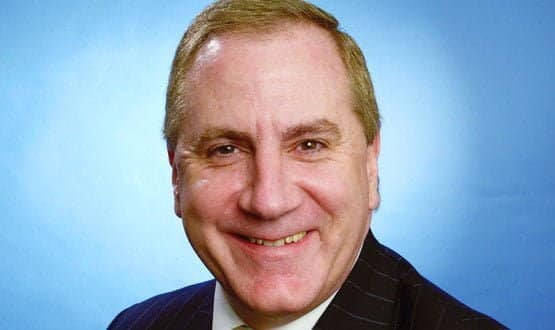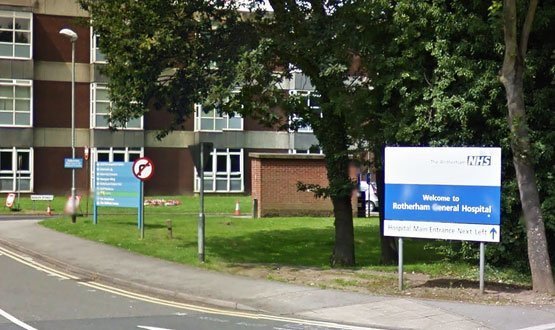The life of Brian
- 3 December 2012

Brian James, the retiring chief executive of The Rotherham NHS Foundation Trust, is not a man to hang about when he has made a decision.
On 20 November, the trust issued a press release to say James was retiring; and on 30 November he was moving boxes out of his office and preparing to switch email and phone details.
“I made plans to retire last year, along with my chair,” he tells eHealth Insider in the middle of this activity. “But at the time, we had four other executive vacancies, so I wanted to get them filled.
“Plus, I hadn’t implemented our electronic patient record, or finished SDS 3 [The Rotherham’s service development strategy for 2012-15, which focuses on how the acute trust can work with – and deliver some of its services in – its local community].
“So, I signed a two year contract with a one-year break-clause. And when I got to it I thought ‘what will I achieve by doing the extra year?’ The EPR is in and the new strategy is in place; so I took the decision not to renew my contract.”
Still, James can expect some eyebrows to be raised in the local press over his departure, since the impact of both the IT programme and the strategic plan on jobs are just starting to dawn on local union leaders and politicians.
James has always been completely clear that change will lead to financial savings that will be visible as job losses; but argued they are vital for the survival of a trust focused on a district general hospital and surrounded by more powerful institutions.
However, with a Conservative-led coalition in government in power, the plans are easy to present as ‘Tory cuts.’ At the same time, there is no doubt that the EPR implementation has been longer and harder than anticipated, and that there are issues to iron out.
Exit NPfIT, stage left
The Rotherham made a high-profile exit from the National Programme for IT in the NHS in 2008. As a trust in the North, Midlands and East, it was scheduled to receive iSoft’s Lorenzo from local service provider CSC.
Yet the development and deployment of Lorenzo ran late from the start. James said then, and says now, that this left the trust with few choices.
Its McKesson patient administration was ageing and not being developed by the company, which had failed to win any NPfIT business. Lorenzo “was not developing at the pace, or with the vision, needed.”
And when the trust asked if it could have the ‘other’ NPfIT ‘strategic’ system – Cerner Millennium – it was “given a flat reaction.”
“So, I talked to the board, and I talked to the doctors, and we decided to go to market,” James says. “There was lots of opposition, at the highest levels, but I had to focus on what was best for the trust.
“It was not just an IT issue. It was clear that the money [the big increases that Labour found for the health service] was likely to run out in 2011, so we had to have a system that would help us to deliver efficiencies and economies.”
In the end, the trust chose Meditech v6.0 – getting around threats that it would have to pay for Lorenzo as well by designating it as an ‘interim’ system – and appointed Perot Systems, now part of Dell, to help with the implementation.
“If I knew portals were going to take off; if I knew McKesson was going to take-over [English PAS provider] System C; if I knew NPfIT was going to collapse completely, I might – might – have done something different,” James says.
“But I am not sure I would. Portals are not the solution to everything; and [clinical system] Meditech Magic is well liked. But it has been very, very hard; I will not pretend that it has not.”
Very, very hard times
The Rotherham signed a deal for Meditech v6.0 in spring 2009 and hoped to start implementation later that year, with a view to having the EPR fully live by spring 2010 and the trust paperless in three years.
In the event, the first phase of the EPR implementation took place over this year’s Diamond Jubilee bank holiday.
James says three issues contributed to these delays; anglicising the system; getting SNOMED coding embedded into it; and integrating with national systems, such as Choose and Book.
Of these, the most unexpected was anglicisation. “We thought we would be ok,” he says. “There were implementations of Meditech Magic in the UK, so we thought they would understand the NHS and that would short-cut the development cycle.
“It turned out that v6.0 is a very, very different system. It is written in a different programming language, by a different team, so that learning has not been transferred across. I think even Meditech did not realise that.”
Problems with “getting the engagement needed” to integrate with national systems were, James implies, not helped by a central reluctance to help a trust making such a prominent exit from the national programme.
But The Rotherham’s work to “fully embed” SNOMED has been “pioneering”; and has shown up problems that the NHS as a whole will have to resolve if SNOMED CT is to become one of its ‘fundamental’ standards by 2015.
“There are real problems matching to OPCS [the codes the NHS uses to classify operations and procedures] and HRG [the Healthcare Resource Groups that underpin Payment by Results],” he explains. “We will need to sort that out if the country is to go SNOMED; and somebody had to go through it first.”
We’ve been here before
James has worked in the NHS for almost 40 years. He told one profiler that he fell into the health service by accident in 1975; joining a supplies department simply because he “needed a job” after family illness forced him to sell his father’s business.
He worked his way up the management chain of a number of hospitals in Cornwall and the South West, developing an interest in IT in the process; and experimenting with the use of Psion hand-held devices to collect community data.
When the Korner Committee produced its reports on health service information in the mid-1980s, James was asked to take up a district-level post to deliver Korner Returns “properly”.
“I was invited to become district information manager, and to take over the IT service, which was PS-based. That system morphed into Swift in the South West, which was quite a good system,” he says.
He still regrets that the NHS did not pursue Dame Edith Korner’s line of thinking. “In the 1980s, we had a common basic specification set out for how data should be collected and coded, and we did not do anything with it,” he says.
“We could have said ‘you can have any IT you like, as long as it matches that’ but we lost it. The next minister came along. The next big thing came along. The NHS is so politicised that we cannot maintain stability long enough to get something right.”
James did a Masters degree in health informatics in Manchester, and worked his way through a number of other director-level jobs, before moving to Darlington in 1993.
Darlington was one of three sites chosen to pilot Hospital Information Support Systems, as outlined in the NHS’ next big idea for computing; its first IT strategy, published in 1992.
James says the McDonnell Douglas system it worked on was also “pretty good” but starved of support once the HISS concept fell out of favour in its turn.
Overall, though, James’ experience seems to have convinced him of two things. First, that IT must be able to improve clinical and organisational performance, and not just deliver financial returns.
And, second, that information is best derived from single, integrated systems, rather than from piecemeal developments that take time and money to integrate.
Ahead of the challenge?
James took both perspectives to The Rotherham, where he became chief executive in 2005, after a stint at South Yorkshire Strategic Health Authority.
The trust has been using McKesson’s InterQual decision-making and review system to examine the patients admitted to A&E and from A&E to wards.
As a result, as part of its strategic planning, it has invested in a 30 bedded community unit and radically extended consultant hours to make sure decision makers are on hand to divert patients to it and other services. However, it is Meditech v6.0 that James wants to deliver very different ways of working.
The coalition government is holding NHS funding flat, at best, while demand is rising. Sir David Nicholson has set a ‘challenge’ for the NHS to find £20 billion of efficiency savings to bridge the gap by 2014-15, of which The Rotherham’s share is around £50m.
So far, it has found £20m; leaving it with £30m to go – a figure that unions and politicians caught up in Rotherham’s bad tempered by-election have equated to 750 jobs.
“I have never used that figure, but the challenge to the workforce is to become that much more efficient, using the facilities and the technology that we have invested in,” James says. “That is the only way to create a sustainable organisation going forward.”
Against this background, he remains convinced that The Rotherham was right to leave a national programme that he still thinks has “put the NHS back ten years”; if only because it has made an investment in IT that other trusts will have to make when their financial circumstances have already worsened.
Not going quietly
On the other hand, he says “my regret is that we probably bit off more than we could chew in terms of go-live” given the problems in getting Meditech ready.
Other trusts, he adds, would be well advised to have a vision for going paperless, but to build towards it by starting with PAS, order communications and case notes.
Despite this, James is convinced the NHS will get there, if not within the timeframe being promoted by its latest information leader.
“This Kelsey [Tim Kelsey, the NHS Commissioning Board’s national director for patients and information] is talking rubbish [when he says in speeches that the NHS will be paperless by 2015]; I don’t know where they got him from,” he snorts.
“The NHS is not going to be paperless by 2015; it is not going to be paperless soon. But it is impossible to imagine that paper is going to be around forever, and that IT won’t deliver the kinds of change that it has delivered to banking and to other industries.”
James will surely have some part to play in the future. It’s impossible to imagine him sitting quietly in a conservatory; indeed he admits that he would “drive my wife mad” and that he is open to “interesting offers.”
“I will not be working because I need to. I will be working because there are interesting things to do,” he says.




